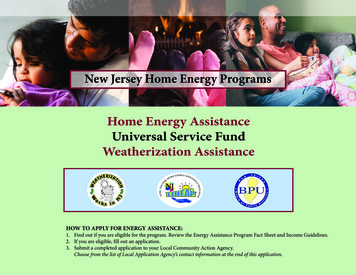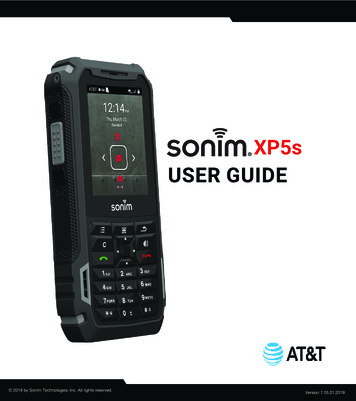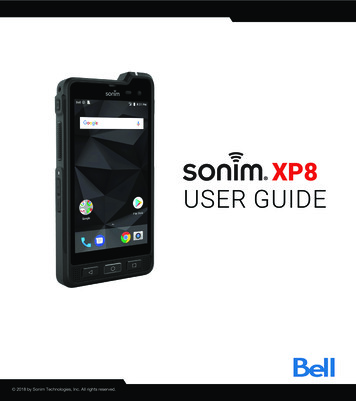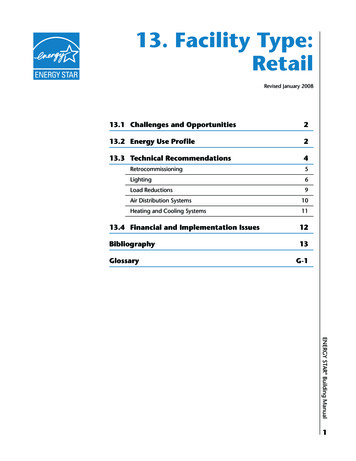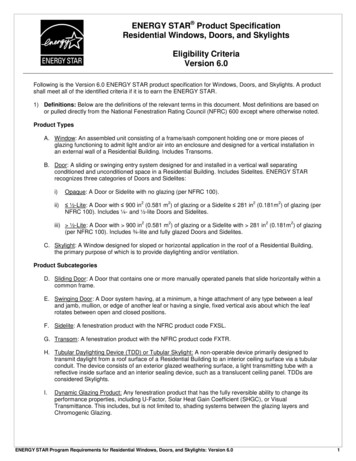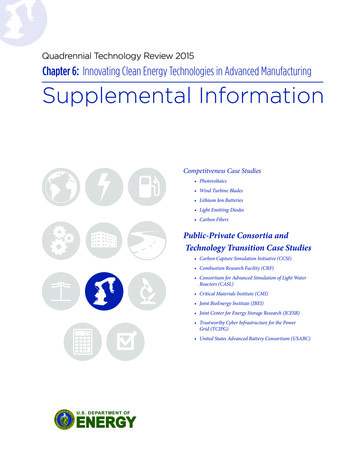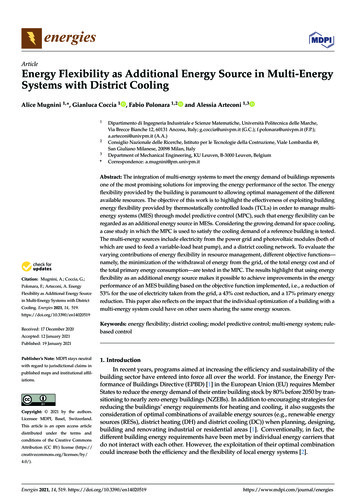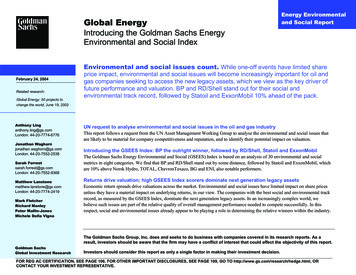
Transcription
New TechnologiesNew SavingsWater Heater Market Profile 2009U.S. Department of Energy
Table of ContentsExecutive Summary1Installed Base2Water Heater Market4Annual Shipments4Manufacture and Distribution6Purchase Drivers7Efficiency and SavingsENERGY STAR Criteria88National Savings Potential11Household Savings12Getting Started13Program Design Options13Federal Tax Credits and State Rebates14Additional Resources14Appendix15Energy and Cost Comparison for Gas Water Heating Options15Energy and Cost Comparison for Electric Water Heating Options16
Executive SummaryThis document is designed to help ENERGY STAR partners understand the unique savings potentialof residential water heaters and develop effective water heater programs.Revolutionary changes in water heater technology coupled with the yearly replacement of roughlyone out of every 13 water heaters create a tremendous opportunity to increase energy efficiency inthe residential sector. With most American households containing conventional water heaters barelymore efficient than the ones sold 20 years ago, energy efficiency program sponsors can achievesignificant, cost-effective savings by adding ENERGY STAR qualified water heaters to their programportfolios.Water heating is the second largest energy end use in homes, behind space heating and cooling.It accounts for 16.8 percent of residential energy consumption and can cost a household anywherefrom 200 to 600 a year.Almost every U.S. household has at least one water heater, and many of them are old. About 27million households have water heaters that are more than 10 years old and are therefore nearingthe end of their functional lives.Each year, about 8 percent of households replace their water heaters. Between 7 million and7.8 million water heaters are replaced in the United States annually. Another 1.2 million to2 million units are installed in new homes.ENERGY STAR qualified water heaters are much more efficient than standard technologies. Mostunits sold today just meet the current Federal standards, which took effect in 2004. ENERGY STARqualified models consume 7 to 55 percent less energy than standard-efficiency models and can savea household 30 to 300 a year on its energy bills.While ENERGY STAR qualified water heaters are more expensive, consumers will recover the pricepremium within the product’s expected lifetime. When installation costs are included, the pricepremium over standard-efficiency units ranges from a low of about 70 for high-efficiency gasstorage models to a high of about 2,500 for solar water heaters.ENERGY STAR qualified water heaters are already widely available. At least 922 gas storage, gastankless, heat pump, and solar water heater models have already qualified for the ENERGY STARlabel. Qualified gas condensing water heaters are expected in 2010.Government incentives will make purchasing ENERGY STAR qualified water heaters moreattractive to consumers. Program sponsors can boost savings by leveraging current Federaltax credits for high-efficiency water heaters. In addition, rebates may be available from Stategovernments in some parts of the country due to funding provided through the AmericanRecovery and Reinvestment Act of 2009.Back to TOC
Installed BaseResidential water heaters supply hot water to almost all of the 79 million singlefamily homes and approximately 21 million multi-family and manufacturedhomes in the United States. As some single-family homes contain more thanone working water heater, there are approximately 103 million residential waterheaters in service nationwide.1 At least 27 million of these water heaters are morethan 10 years old and therefore are nearing the end of their functional lives.2Just over half of all homes (53 percent) are served by gas water heaters; mostof the rest are served by electric (40 percent). Other energy sources for waterheating include fuel oil (used primarily in the Northeast), propane, wood,and solar.3 Gas is the dominant water heating fuel in the West, Midwest, andMiddle Atlantic. Electric water heaters are more common in the East SouthCentral and South Atlantic census divisions and in the Pacific Northwest.Prevalence of Gas Water Heating by Census Division, 2005WESTMIDWESTWestNorth Central64%EastNorth Central66%Pacific70%NORTHEASTNew England42%Middle Atlantic58%South Atlantic25%Mountain65%WestSouth Central52%EastSouth Central29%SOUTHSource: Analysis by D&R International, Ltd. of micro data from Residential EnergyConsumption Survey, Energy Information Administration, 2005.Water heating accounts for 16.8 percent of home energy use, measured at thesite, and can cost a household anywhere from 200 to 600 a year, dependingon the amount of hot water used and fuel prices.4 To help control energyconsumption, Congress established minimum efficiency standards for waterheaters in 1987 based on fuel and capacity. The original standards, which tookeffect in 1990, required a minimum energy factor (EF)5 of 0.525 for gas waterheaters and 0.864 for electric water heaters with a 50-gallon tank. The currentstandards, which took effect in January 2004, require a minimum EF of 0.575 forgas water heaters and 0.904 for electric water heaters with a 50-gallon tank. TheU.S. Department of Energy (DOE) is developing amended minimum efficiencystandards that are expected to take effect in 2013.6Back to TOCENERGY STAR Water Heater Market Profile and Program Design Guide, Page 2
A water heater will last 10 to 20 years, depending on the type of unit and thehardness of the water. The average age at replacement is 13 years.7 Thus, mostof the installed base has turned over since standards took effect in 1990.About 40 million units in the installed base were manufactured after the January2004 standards took effect. Another 50 million units were manufactured between1990 and 2003. The remaining 7 million units pre-date the Federal standards.Most units sold since 1990 have just met the prevailing efficiency standards.8U.S. Installed Base by Year of Manufacture30Millions of Water HeatersGas2927Electric2422212218171512963043Before 19901990-20032004-2009Note: Secondary water heaters are not included in the installed base in this analysis.Source: Analysis by D&R International, Ltd. of data from Residential Energy ConsumptionSurvey 2005, Energy Information Administration, Table HC2.8.Minimum Energy Factor for a Fifty-Gallon Water HeaterFederal StandardFuelENERGY STARCriteria*Effective 1990Effective 2004Effective 2013Gas0.5250.575TBD0.62 to 1.2Electric0.8640.904TBD1.8 to 2.0* Solar water heaters are required to have a solar fraction of at least 0.50. This is equivalent toan energy factor of 1.2 for systems with gas backup and 1.8 for systems with electric backup.Source: Energy Conservation Program for Consumer Products: Energy ConservationStandards for Water Heaters; Final Rule,” Federal Register, Jan. 17, 2001 (66 FR 4474).Back to TOCENERGY STAR Water Heater Market Profile and Program Design Guide, Page 3
Water Heater MarketAnnual ShipmentsWater heater shipments averaged 9.2 million units per year over the last 10years. The market is evenly split between electric and gas. Electric units havegained market share in recent years because new housing construction wasconcentrated in the South, where electric water heating predominates. Roughly80 percent of new units replace old units; the remaining 20 percent are used innew construction. Sales in 2008 totaled 8.2 million units, down 15 percent fromthe peak in 2004, due largely to contraction in the home construction industry.9Water Heater Shipments, 1999-20081098Millions of Water Heaters7Electric:Replacement6543Electric:New HomeGas:New HomeGas:Replacement210Electric Water HeatersUnits Installed in New 07200846%46%47%47%46%48%48%51%50%51%1,861 es: “56th Annual Report: Statistical Review,” Appliance Magazine, May 2009, and analysisby D&R International, Ltd. of data from the U.S. Census Bureau on new home constructionand placements of manufactured homes.Back to TOCENERGY STAR Water Heater Market Profile and Program Design Guide, Page 4
Traditional storage water heaters (tank style) make up about 97 percent of themarket. Tankless (also called “instantaneous” or “demand”) models are slowlygaining market share, with gas tankless models accounting for 3 percent ofall units sold in 2006. All other technologies together accounted for less than1 percent of the market.10Water Heater Market by Fuel and Technology, 2006Electric Storage(49%)Gas Tankless(3%)Other( 1%)Gas Storage(48%)Source: “ENERGY STAR Residential Water Heaters: Final Criteria Analysis,"U.S. Department of Energy, April 1, 2008.Note: The most recent market data available is from 2006.Back to TOCENERGY STAR Water Heater Market Profile and Program Design Guide, Page 5
Manufacture and DistributionA.O. Smith, Rheem Manufacturing,and Bradford White manufacture 88percent of residential water heaters.More than two dozen companiesmanufacturer the remaining 12percent. Rheem leads the marketfor tankless units, selling morethan half of all models. Solar waterheaters are sold largely by smallercompanies.11 See www.energystar.gov/waterheaters for a completelist of ENERGY STAR manufacturerpartners.12Water Heater ManufacturerMarket Share, 2006A.O. Smith(37%)Bradford White(14%)Others(12%)RheemManufacturingRetailers, wholesalers, distributors,(37%)and plumbers make up the waterheater distribution chain. Wholesalersand distributors account for half ofwater heater sales; plumbers buy 87Sources: “A Portrait of the U.S. Appliancepercent of these, mostly for resale toIndustry,” Appliance Magazine, Sept.homeowners. Retailers account for2007, and A.O. Smith Water ProductsCompany homepage,the remainder of water heater sales;www.aosmith.com/prod/wpc.htm.homeowners buy 85 percent of these.Together, homeowners and plumberspurchase 86 percent of all waterheaters. Commercial property owners,remodelers, and builders buy the remaining 14 percent. Of those purchased byhomeowners at retail, almost two-thirds are installed by the homeowner, whileplumbers install the rest.13Water Heater Distribution ChannelsRetailers (50%)Property Owners(6%)Homeowner buysand plumber installs(16%)Remodelers(2%)Homeowner buysand %)Property Owners(4%)Wholesalers/Distributors (50%)Source: D&R International, Ltd. based on interviews with water heater manufacturers.Back to TOCENERGY STAR Water Heater Market Profile and Program Design Guide, Page 6
The top three water heater retailers are Sears, The Home Depot, and Lowe’s.Together, they are responsible for almost 43 percent of retail sales. Among thethousands of wholesalers and distributors nationwide, the three largest areFerguson, Johnstone Supply, and Winnelson. Some manufacturers sell only towholesalers, while others sell to retailers and wholesalers.Purchase DriversHomeowners replace water heaters for three major reasons: 1) the unit failscompletely, 2) the performance of the unit becomes unacceptable, or 3) thehomeowner decides it’s time for a new one. In a 2005 survey of consumersin the Northwest who planned their water heater replacement, 43 percentsaid “it was getting old and it was time to replace it before it broke.”Another 25 percent said “we wanted a more efficient unit.”14,15Reasons for Purchasing a Water ompleteFailure(30%)PoorPerformance(20%)Source: D&R International, Ltd. based on interviews with water heater manufacturers, and“Assessment of the Residential Water Heater Market in the Northwest,” Northwest EnergyEfficiency Alliance, Report #E06-158, July 13, 2006.The factors most likely to influence a consumer’s water heater selection arefuel type; tank size; warranty; price; and, especially in the case of emergencyreplacement, speed of procurement and installation. Recommendations fromsalespeople, friends, or family and the way retailers and plumbers present theoptions also strongly influence the product choice.16Back to TOCENERGY STAR Water Heater Market Profile and Program Design Guide, Page 7
Efficiency and SavingsENERGY STAR CriteriaThe energy efficiency of the installed base is likely to rise steadily, possiblydramatically, over the next 10 years with the arrival of ENERGY STAR qualifiedwater heaters. In April 2008, DOE announced final ENERGY STAR criteria, whichapply to five types of water heaters. They range from improved versions ofthe dominant gas storage design, which cut energy consumption by about 7percent, to super-efficient technologies that use half the energy of conventionalmodels.The ENERGY STAR criteria, which took effect in January 2009, includeminimum requirements for energy efficiency, first hour ratings, warranties, andcompliance with certain safety standards. As of August 25, 2009, 922 ENERGYSTAR qualified water heater models were on the market.ENERGY STAR Water Heater CriteriaType of WaterHeaterMinimum EnergyFactorMinimum FirstHour Rating**MinimumWarrantySafetyHigh-EfficiencyGas Storage0.62 until 8/31/10;0.67 thereafter67 gallonsper hour6 years on sealedsystemCompliance withANSI† Z21.10.1/CSA 4.1Whole-Home GasTankless0.822.5 gallonsper minuteat a 77 F rise10 years on heatexchanger and 5years on partsCompliance withANSI† Z21.10.1/CSA 4.1 or ANSIZ21.10.3/CSA 4.3,depending onburner sizeGas Condensing0.867 gallonsper hour8 years on sealedsystemCompliance withANSI† Z21.10.1/CSA 4.1Heat Pump2.050 gallonsper hour6 years on sealedsystemCompliance withUL†† 174 andUL 1995—10 years on solarcollector, 6 yearson storage tank, 2years on controls,and 1 year onpiping and partsOG-300certification fromSRCC†††Solar0.50 SolarFraction*Notes: * Based on the Solar Rating and Certification Corporation’s (SRCC) conversion formula:Solar Fraction 1 – (Energy Factor/Solar Energy Factor), assuming a 0.6 or 0.9 energy factorfor gas or electric backup, respectively.** The first hour rating is the amount of hot water in gallons the heater can supply in the firsthour starting with a tank full of hot water.† The American National Standards Institute (ANSI) assists other organizations in thedevelopment of safety standards for many different appliances, including gas water heaters.The Z21.10.1/CSA 4.1 standard applies to water heaters that burn at 75,000 BTU per hour orless and sets guidelines for safe operation. Gas water heaters with burners that operate atover 75,000 BTU/hour must comply with the Z21.10.3/CSA 4.3 standard.†† Electric water heaters, such as heat pump water heaters, are tested under UnderwritersLaboratories (UL) 174. This standard is a set of guidelines for proper functioning and design ofelectric water heaters.††† SRCC’s OG-300 standard outlines minimum quality and operational requirements for solarwater heaters.Back to TOCENERGY STAR Water Heater Market Profile and Program Design Guide, Page 8
Profiles of ENERGY STAR Water Heater TechnologiesHigh-Efficiency Gas StorageInnovationsImproved insulation, more effectiveheat traps, less burner waste, lessfuel in the combustion reactionEnergy Consumption242 therms/year, 7% less thanstandard storage models (224therms/year, 14% less than standardstorage models starting in Sept 2010)AdvantagesEasy and inexpensive upgrade fromstandard-efficiency units; samemethods, size, hook-upsDisadvantagesHigher operating costs relativeto other ENERGY STAR qualifiedmodelsAvailability320 models as of August 25, 2009Whole-Home Gas TanklessInnovationsFlow-sensor-activated heatingmechanism, improved venting,no standby lossesEnergy Consumption183 therms/year, 30% less thanstandard storage modelsAdvantagesProvides continuous delivery of hotwater; takes up less space becausethere is no storage tankDisadvantagesHigher installation costs (two to fourtimes greater than for conventionalstorage models); often requires awider gas supply line and a largervent than a typical gas storage model,which can make changing from a tankto a tankless system in an existinghome difficult in some casesAvailability440 models as of August 25, 2009InnovationsCaptures more heat from combustionEnergy Consumption187 therms/year, almost 30% lessthan standard storage modelsAdvantagesSimilar size as conventional storagemodelsDisadvantagesMay require the installation of apowered vent and/or a condensatedrain, making emergencyreplacement of a standard modelwith this type difficult in some casesAvailabilityExpected in 2010Gas CondensingContinuedBack to TOCENERGY STAR Water Heater Market Profile and Program Design Guide, Page 9
Profiles of ENERGY STAR Qualified Water Heater TechnologiesSolarInnovationsUses the sun’s energy to heat waterEnergy Consumption130 therms/year or 2,429 kWh/yearfor backup, both 50% less thanstandard storage modelsAdvantagesVisible indication of one’scommitment to reducing energyconsumption; some models canwork well in overcast conditions andoperate in temperatures as low as-40 FDisadvantagesHigh initial cost; requires the use ofa backup gas or electric water heater,usually a conventional storagemodel; may require more frequentmaintenanceAvailability160 models as of August 25, 2009InnovationsInstead of generating heat, useselectricity to move heat fromsurrounding air to the waterEnergy Consumption2,195 kWh/year, 55% less thanstandard storage modelsAdvantagesCools and dehumidifies the space inwhich it’s installed, a benefit duringthe cooling season, especially inmore humid climatesDisadvantagesInstallation is complicated andrequires a trained professional;requires a condensate drain andperiodic air filter cleanings; coolsand dehumidifies the space in whichit’s installed, a disadvantage duringthe heating season if installed inconditioned spaceAvailability2 models as of August 25, 2009Heat PumpNote: More detailed profiles of the five technologies are included in DOE’s 2009 “ENERGYSTAR Water Heater Partner Resource Guide.”Back to TOCENERGY STAR Water Heater Market Profile and Program Design Guide, Page 10
National Savings PotentialRevolutionary changes in water heating technology coupled with the yearlyreplacement of roughly one out of every 13 water heaters create a tremendousopportunity to increase energy efficiency in the residential sector.ENERGY STAR qualified water heaters currently account for only 6 to 7percent of sales and less than 1 percent of the installed base.17 If all homeshad ENERGY STAR qualified models, the United States could save 1 billion to6.8 billion therms, 98 billion to 107 billion kWh, and 12 billion to 22 billion,depending on technology choices.18 This is 1.16 to 1.85 quadrillion BTU per yearof primary energy, a 40 to 64 percent savings.19Energy Savings Potential from ENERGY STAR Water Heaters3.0Primary Energy(Quadrillion BTU)2.51.16(40%)1.85(64%)Low Savings ScenarioHigh Savings Scenario2.01.51.00.50Status QuoNote: Assumes 52.5 million gas homes acquire high-efficiency gas storage units (EF 0.62)in the low savings scenario and solar water heaters with gas backup in the high savingsscenario. Assumes 40.3 million electric homes acquire solar water heaters with electricbackup in the low savings scenario and heat pump water heaters in the high savings scenario.Estimates of primary energy savings potential assume a 3.18 site-to-source conversion factorfor electricity.Source: Analysis by D&R International, Ltd. using data from "Residential Energy ConsumptionSurvey 2005," Energy Information Administration, Table HC2.8 and Annual Energy Outlook2009, Energy Information Administration, Table 4.Back to TOCENERGY STAR Water Heater Market Profile and Program Design Guide, Page 11
Household SavingsAn ENERGY STAR qualified water heater can save a household 30 to 300a year on its energy bills. Qualified tankless and solar models can last up to20 years, making them more durable than their less efficient counterparts.Although installation costs are higher for some models, particularly he
Water heating accounts for 16.8 percent of home energy use, measured at the site, and can cost a household anywhere from 200 to 600 a year, depending on the amount of hot water used and fuel prices.4 To help control energy consumption, Congress established minimum efficiency standa


